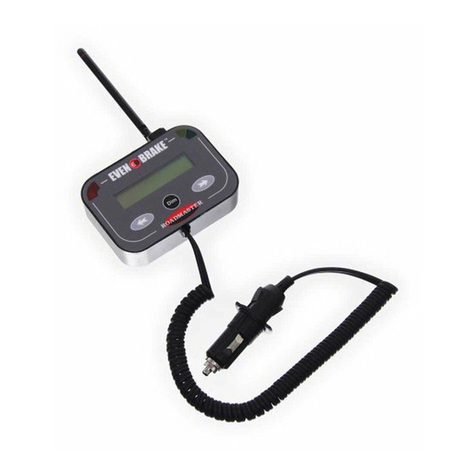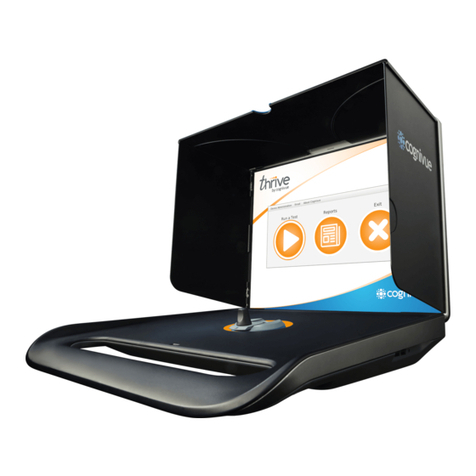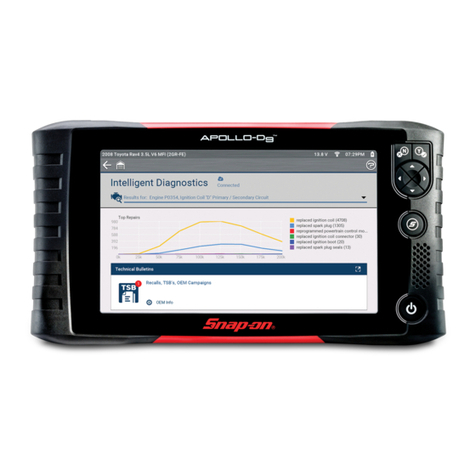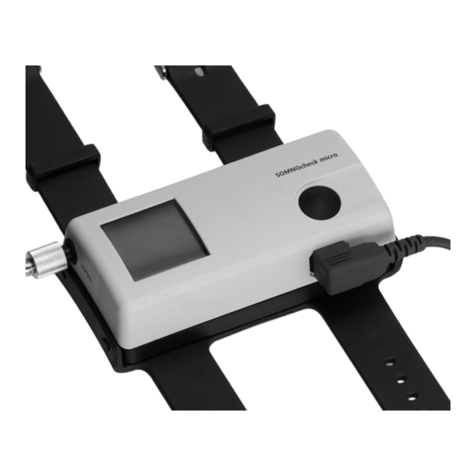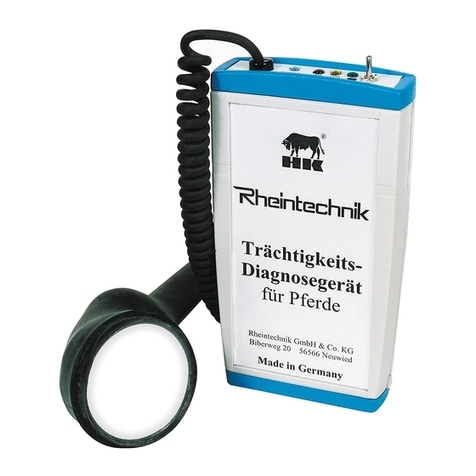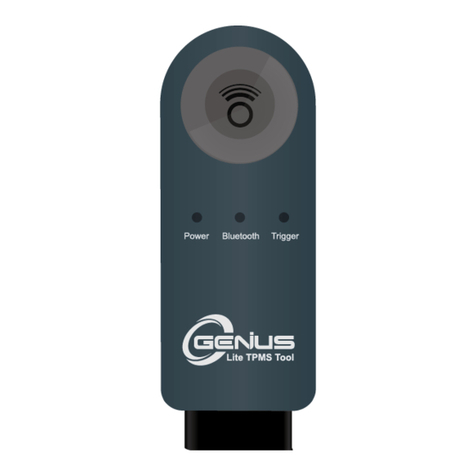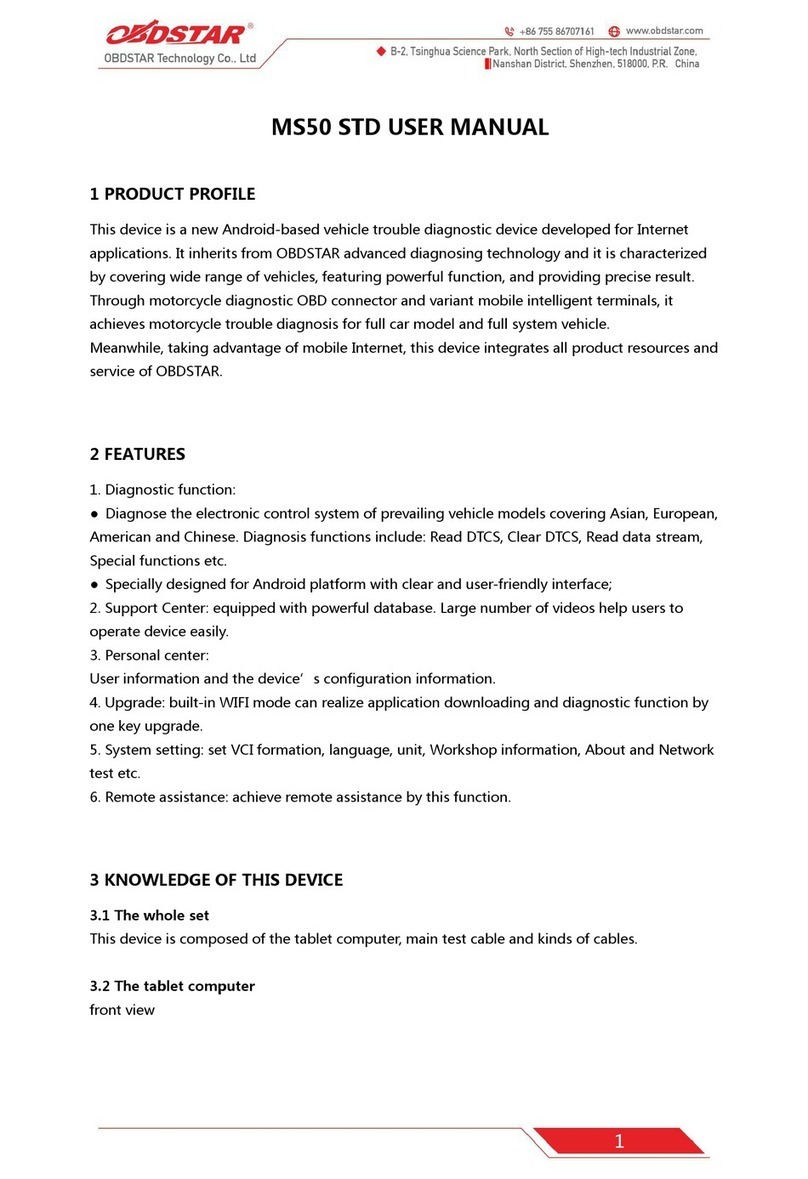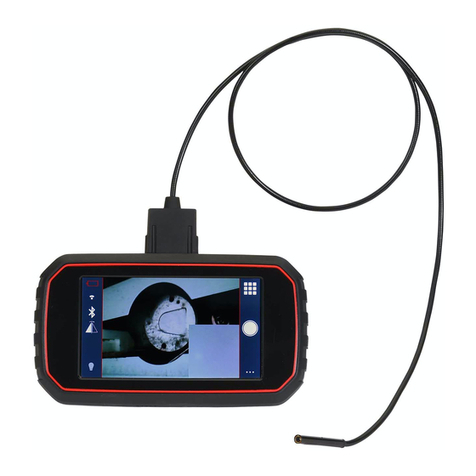Roadmaster AddaBRAKE 8800 User manual

Towing and Suspension Solutions
ROADMASTER,Inc.•6110NE127thAve•Vancouver,WA98682
800-669-9690•fax360-735-9300•roadmasterinc.com
85-3476rev.0208/08©2008ROADMASTER,Inc.
Owner’s Manual
Partnumber8800
Entire contents of manual must be read by owner

The AddaBRAKE serial number…
…is on a label on the underside of the unit. You
will need this number when you fill out your product
registrationcard.
Write down the serial number in the space below
andretainforfuturereference…
Serialnumber:
ThismanualhasbeenpreparedtoacquaintyouwiththeinstallationandoperationofyourAddaBRAKE,andto
provideyouwithimportantsafetyinformation.
Readyourowner’smanualcovertocover.UnderstandhowtoinstallandoperateyourAddaBRAKE,andcare-
fullyfollowtheinstructionsandsafetyprecautions.
YourAddaBRAKEhasaone-yearlimitedwarranty.Toqualifyforyourwarranty,filloutandreturntheenclosed
productregistrationcardwithin30daysofpurchase.As a bonus, we’ll extend your warranty to a total of two
years at no additional cost, if we receive the product registration card within 30 days of purchase.
Wethankyouforyourpatronageandgreatlyappreciateyourdiscerningtaste.
WELCOME TO THE ROADMASTER FAMILY!
IMPORTANT NOTICE!
Safety Definitions
Thismanualcontainsinformationthatisveryimportanttoknowandunderstand.Thisinformationisprovidedfor
safetyandtoprevent equipment problems.Tohelprecognizethisinformation,observethefollowingsymbols:
WARNING indicates a potentially hazardous situ-
ation which, if not avoided, could result in property
damage, serious personal injury, or even death.
CAUTION indicates a potentially hazardous situ-
ation which, if not avoided, may result in property
damage, or minor or moderate personal injury.
CAUTION used without the safety alert symbol
indicates a potentially hazardous situation which,
if not avoided, may result in property damage.
NOTE
Refers to important information and is placed in italic
type. It is recommended that you take special notice of
these items.
AddaBRAKE specifications
Height ...........................................................12inches
Width........................................................ 11.25inches
Length...........................................................16inches
Weight...................................................... 15.5pounds
Voltage...................................................... 12voltsDC
Operatingtemperaturerange
...............................-2°to+150°F(-19°to+66°C)
Lengthofstandardpowercord.....................42inches
Maximumamperagedraw .......................... 10.8amps
Idleamperagedraw............................................ 11mA
Approximatemaximumairpressure .................. 60psi
Maximumforceextendedonbrakepedal ...... 106lbs.
MinimumspaceAddaBRAKEcanfit ............16inches

TABLE OF CONTENTS
Specifications....................................insidefrontcover
Safetydefinitions ..............................insidefrontcover
Components............................................................... 2
Wiringdiagrams......................................................... 3
Initial Installation
Beforeyoubegintheinitialinstallation
(installer’schecklist) ........................................... 4-5
Initialinstallation ................................................... 6-11
Installthebreakawaysystem ............................... 6
Modificationstothe
towedvehicle’slightingsystem ...................... 6-7
Installthemotorhomemonitor
wiringharnessinthetowedvehicle ............... 7-8
Attachthebrakesignalwire............................... 8-9
Attachthefirewallgrommet;
attachthewiringconnectors ....................... 9-10
InstallthemotorhomemonitorLED..................... 10
Testthebrakingsystem ................................. 10-11
Day-to-Day Operation
Attachthepedalclamp....................................... 12-13
Adjustthefeetandtheseatpad ........................ 13-14
Pluginthepowercord ....................................... 14-15
Testandadjustpositioning;
depletethevacuuminthepowerbrakes ............ 15
Setthebrakepressure ............................................ 16
Connectthewiringharness;
testthebreakawaysystem............................ 16-17
Connectthemotorhomemonitorpatchcord ........... 17
Testthebrakingsystem...................................... 17-18
Protection Modes
Extendedbrakingprotection.................................... 18
Respondingtoanaudioalert .................................. 18
Quick Reference Checklist
ConnectingAddaBRAKE .................................... 19-20
DisconnectingAddaBRAKE..................................... 20
Troubleshooting .................................................. 21-22
Ford‘neutraltow’vehicles.................................. 23-24
Optionalequipment.................................................. 25
Limitedwarranty ...................................................... 26
Index........................................................................ 27
Read all instructions before installing or oper-
ating AddaBRAKE. Failure to understand how to
install or operate AddaBRAKE could result in prop-
erty damage, personal injury or even death.
Not for use on older vehicles without power
brakes. AddaBRAKE is designed to work with ve-
hicles that have a power brake system (even though
the power brakes are not activated while towing).
Using AddaBRAKE on vehicles that do not have
power brakes will result in over-braking and severe
non-warranty brake damage.
Do not install AddaBRAKE in a vehicle with an
‘active’ braking system.
‘Active’ (or, ‘continuous power assist’) braking
systems are a safety feature on some new vehicles.
This feature allows the brakes to always have pow-
er, even with the ignition off. The only supplemental
braking system that ROADMASTER manufactures
for these vehicles is BrakeMaster, with the addition
of a Brake Pressure Reducer (part number 900002).
If any ROADMASTER supplemental braking sys-
tem other than a BrakeMaster with a Brake Pres-
sure Reducer is installed, the vehicle will brake
with excessive force, which will damage the tires.
Other non-warranty damage may also occur.
It is the owner’s responsibility (or if profession-
ally installed, the installer’s responsibility) to de-
termine if the vehicle being equipped with supple-
mental brakes has an active braking system — refer
to the owner’s manual, the vehicle manufacturer or
the dealership.
ROADMASTER expressly disallows any and all
claims relating to tire damage, brake damage, or
any other damage to vehicles with ‘active’ braking
systems caused by: 1) installation of any ROAD-
MASTER supplemental braking system other than
BrakeMaster; or 2) failure to install a Brake Pres-
sure Reducer with the BrakeMaster.
1

COMPONENTS
2
part
number description
1 9329 ....................brakepedalclamp
2 n/a .......................aircylindershaft
3 n/a .......................pressuregauge
4 n/a .......................regulatorcontrolknob
5 n/a .......................airreliefbutton
6 n/a .......................testbutton
7 650996.................adjustableseatpad
(handleassembly)
8 450952.................adjustmentknob
9 450105.................adjustablefeet
10 450103.................12-voltpowercord 8
9
4
13
2
5
Itemsnotshowntoscale.
Optionalequipmentislistedinthe
“OptionalEquipment”section.
6
16
3
10
11
7
part
number description
11 650906.................AddaBRAKEwiringharness
12 650900.................breakawaywiringharness
13 8602 ....................breakawaycable
14 650898.................breakawayswitch
15 650906-01 ...........brakesignalwire
16 300065-00 ...........motorhomemonitorLED
17 9325 ....................audiosignalcircuitboard
18 450008.................motorhomemonitorpatch
cord(notpictured)
1
15
17 12
14

3

1. ALWAYS CHECK THE ROADMASTER WEB SITE —
www.roadmasterinc.com—forvehicle-specificinforma-
tion.Select‘Vehicle-SpecificInfo,’enterthemotorhome
andtowedvehiclemake,modelandyear,thenselect
‘BrakingSystems.’
2. If the battery must be disconnectedfortowing,
a12-voltoutletkit(partnumber9332)andastoplight
switchmustbeinstalled.ROADMASTERmanufactures
stop light switch kits for a number of vehicles; to
see if one is available for any specific vehicle, visit
www.roadmasterinc.com and select ‘Vehicle-Specific
Info,' enter the vehicle make, model and year, then
select‘BrakingSystems'andscrolldownthepage.
Note: if a stop light switch kit is listed on the web
site for any particular vehicle, it is required.
Note: an Automatic Battery Disconnect (part number
765) is available for vehicles which must be towed with
the battery disconnected. If you choose to install the
Automatic Battery Disconnect, a 12-volt outlet kit and a
stop light switch are still required; the Brake-Lite Relay
(see below) is not required.
3. If fuse(s) must be removed from the vehicle be-
fore it can be towed—verifythatremovingthefuse(s)
willnotdisruptpowertoAddaBRAKE,orotherwiseaf-
fecttheinstallationoroperation.
4. Check the towed vehicle’s 12-volt outlet for
correct power —AddaBRAKEispoweredthroughthe
12-voltoutlet,withtheignitionkeyturnedtothe“tow”
position.However, somevehiclesonly have powerat
the 12-volt outlet when the engine is running. Before
you begin the initial installation, verify that you have
power at the towed vehicle’s 12-volt outlet with the
ignitionkeyturnedtothe“tow”position.
Ifthereisnopower,youcaninstalltheoptional12-
voltoutletkit(partnumber9332).Wheninstalled,this
kitwill providepower to the12-volt outleteven when
theengineisoff.
5. Check the 12-volt outlet sockettomakecertain
that:a)thesockethasbeenwiredcorrectly;andb)the
socketisnotcorroded.
a. Make certain that the socket has been wired cor-
rectly—thecontactpointatthebottomofthesocket
shouldbepositive,andtheoutershellaroundthetop
ofthesocketshouldbenegative.
If the socket’s positive and negative connections
have been reversed, the fuse in the AddaBRAKE
power cord will blow when the cord is plugged into
the 12-volt outlet.
b. Make certain that the socket is not corroded
or otherwise damaged—acorrodedsocketmaynot
provide constant power to AddaBRAKE, which may
Before you begin the initial installation…
causeintermittentoperation.
Ifthesocketiscorrodedordamaged,youcanin-
stalltheoptional12-voltoutletkit(partnumber9332).
Wheninstalled,thiskitwillprovideconstantpowerto
AddaBRAKE.
If the towed vehicle has a single 12-volt outlet
which has been used to heat a cigarette lighter plug,
install the optional 12-volt outlet kit for the Adda-
BRAKE power supply.
Using a cigarette lighter plug in a 12-volt socket
will corrode the contact points. The socket will not
supply sufficient voltage to be used as the Adda-
BRAKE power source — AddaBRAKE may not oper-
ate, or may only operate intermittently.
6. The circuit at the towed vehicle’s 12-volt outlet
must be rated at NO LESS THAN 15 AMPStopower
AddaBRAKE.Checkthefuseattheoutlet—ifthefuse
isratedat15ampsorhigher,thecircuitisadequateto
powerAddaBRAKE.Ifthefuseisratedatlessthan15
amps,installtheoptional12-voltoutletkit(partnumber
9332). When installed, this kit will provide power to
AddaBRAKE.
If the circuit at the 12-volt outlet is rated at less
than 15 amperes, install the optional 12-volt outlet
kit. Depending on the available current during tow-
ing, AddaBRAKE may not function, or may function
incorrectly, without at least 15 amps.
If the circuit is rated at less than 15 amps, do not
simply replace the outlet’s fuse with a higher-am-
perage fuse. This will cause the wiring to overheat,
which can cause wiring damage, an electrical fire,
or other consequential, non-warranty damage.
Failure to follow these instructions may cause
property damage, personal injury or even death.
7. Check the towed vehicle’s brake lights—Adda-
BRAKE must function with the ignition key turned to
the“tow”position.However,somevehicles’brakelights
only operate with the key turned to the “on” position.
Checktoseeifthisisthecase:turntheignitionkeyto
the“tow”position,applythebrakes,andchecktosee
ifthebrakelightsilluminate.Ifthebrakelightsdonot
illuminate, a two-prong stop light switch and 10-amp
fusemustbeinstalled.
Note: check the owner’s manual to see if the vehicle
is equipped with an “automatic shut down” feature. If
continued on next page
4

Before you begin the initial installation…
continued from preceding page
this is the case, ensure that the vehicle is not in auto-
matic shut down mode before performing this test.
ROADMASTERmanufacturesstoplightswitchkits
foranumberofvehicles;toseeifoneisavailablefor
anyspecificvehicle,visitwww.roadmasterinc.comand
select ‘Vehicle-Specific Info,’ enter the vehicle make,
model and year, then select ‘Braking Systems' and
scrolldownthepage.
Note: if you must install a Brake-Lite Relay — see
step 9, below — a stop light switch is not required.
8. If the towed vehicle has a magnetic tow light
system— modificationswill benecessary,in orderto
permanentlyattachthebrakesignalwire.RefertoStep
Dunder“InitialInstallation”—“Attachthebrakesignal
wire,”step2c.
9. An optional Brake-Lite Relay may be required.
Seepageseven forinstructionsonhow todetermine
iftherelaymustbeinstalled.
Note: a stop light switch (see steps 2 and 7 above)
and a Brake-Lite Relay are mutually exclusive — if you
use one, the other is not necessary.
10. If the towed vehicle will be (or has been) wired
for towing—diodesmustbeattachedtothewires.
Theelectricalcircuitthatturnsthetowedvehicle's
brakelightsonandoffalsoturnsAddaBRAKEonand
off. If diodes are not attached, electrical feedback
through the brake light wire will prevent AddaBRAKE
from releasing braking pressure. AddaBRAKE will be
activated with the brake lights, but will not release
brakingpressureuntiltheextendedbrakingprotection
mode overrides the brake signal, after approximately
15seconds.
If the vehicle will be wired for towing, diodes
must be attached in order for AddaBRAKE to re-
lease the towed vehicle's brakes in tandem with the
motorhome. If diodes are not attached, AddaBRAKE
will apply braking pressure for approximately 15
seconds each time the motorhome brakes are ap-
plied, regardless of when the motorhome brakes
are released.
Damage to the towed vehicle's braking system, as
well as other consequential damage, may occur.
Additionaldiodesarenotrequiredif…
• …aBrake-LiteRelay(partnumber88400)mustbe
installedinthetowedvehicle;or
• …anon-intrusivewiringmethodisselected—either
ataillightwiringkit(partnumber155)ormagnetictow
lights(partnumber2100or2120).
A wiring kit with diodes is available from ROAD-
MASTER — the Universal Wiring Kit, part num-
5
ber 154. Additional diodes may also be purchased
separately. Wiring diagrams are under ‘Support’ at
www.roadmasterinc.com.

In addition to wiring and connection instructions, this section contains information about the components of
yoursupplementarybrakingsystem,andhowtheyfunction.Forthatreason,readthissection,evenifyouwill
notbeinstallingthesecomponentsyourself.
Step A
Install the break away system
“Breakaway”systemsaresecondarysafetydevices,
required by law in many states, which will brake the
towedvehicleifitseparates(“breaksaway”)fromthe
motorhome.
1. Mountthebreakawayswitch(Figure1)atthefront
ofthevehicle,onthedriver’sside.Chooseanareayou
caneasilyreach,withasurfaceofsufficientstrengthto
holdtheswitchfirmlyinplace,sothatthebreakaway
pin(Figure1)willpullfreelyfromtheswitch.Mountthe
switchinahorizontalposition,withthebreakawaypin
facingtowardthemotorhome.
Ensurethatthebreakawaypincanbepulledfree-
ly away from the towed vehicle, without any obstruc-
tions.
Do not attach the break away switch to the tow
bar or the tow bar bracket. If the tow bar or bracket
fails, the break away switch will separate with it,
preventing the break away system from activating.
If the towed vehicle separates, the brakes will not
be applied, which may cause property damage, per-
sonal injury or even death.
2. Thebreakawaywiringharness(Figure1)connects
thebreakawayswitchtoAddaBRAKE.Itwillberouted
throughthefirewall,onthedriver’sside.
Lookforapre-existingholeinthefirewall(or,ifthere
is sufficient space, a pre-existing grommet with other
wiring)closetotheflooronthedriver’sside,toroute
thebreakawaywiringharnessthroughthefirewall.
Note: the motorhome monitor wiring harness (Step
C) and the brake signal wire (Step D) will also be routed
through this hole.
Ifthereisnopre-existingholeorgrommetwithsuf-
ficientspace,drilla1/2"holethroughthefirewall.
Drillfromtheenginecompartmentorfromthein-
terior of the vehicle, whichever is more convenient.
Beforedrilling,makecertainyouwillnotdamageany
componentsontheothersideofthefirewall.
3. Routethewiringharnessfromthebreakawayswitch
tothefirewall(or,fromthefirewalltothebreak away
switch,whicheverismoreconvenient),avoidinglines,
hoses,movingpartsor“hot”componentssuchasex-
haustsystems.
Whereappropriate,usewiretiestosecurethebreak
Figure 1
INITIAL INSTALLATION
awaywiringharness.
Atthefrontofthevehicle,connectthewiringhar-
nesstothebreakawayswitch.
Youwillconnectthebreakawaywiringharnessto
AddaBRAKEinalaterstep.
Step B
Modifications to the
towed vehicle’s lighting system
Asupplementalbrakingsystemwillaffecttheopera-
tion of the vehicle’s tow lighting system. Use the fol-
lowinginformationtodetermineifoptionalaccessories
mustbeinstalledinavehiclewhichhasbeenwiredfor
towing — or, if no lighting system has been installed,
whichsystemsareappropriate.
1. First, identify the type of brake and turn signals
in the vehicle. There are two types — combined or
separate.Inacombinedsystem(Figure2),thebrake
continued on next page
6

Modifications to the towed
vehicle’s lighting system
continued from preceding page
lightdoestheflashingfortheturnsignal;inaseparate
system(Figure2), there are amber or red turnsignal
lightswhichareseparatefromthebrakelights.
2. Next,testtoseeifthetowedvehicle’sbrakelights
willilluminatewiththeengineoff—turntheignitionkey
tothe“tow”position,pressthebrakepedal,andcheck
thebrakelights.
3. Basedonwhetherornotthebrakelightsilluminate,
andthetypeofbrakeandturnsignals,therearethree
possibilities:1)thebrakelightsilluminateandthetowed
vehicle has combined lighting; 2) the brake lights il-
luminateandthetowedvehiclehasseparatelighting;
or 3) the brake lights do not illuminate. Choose from
the appropriate list below to install either an optional
accessoryoranotherlightingsystem.
(If you choose to install a system of diodes and
rewire the vehicle’s turn signals, taillights and brake
lights for towing, wiring diagrams are available at
www.roadmasterinc.com.)
1. If the brake lights illuminate and the
towed vehicle has combined lighting…
…oneofthethreealternativesbelowisrequired.
A. Asystemofdiodes
(the vehicle’s turn sig-
nals,taillightsandbrake
lightshavebeenrewired
for towing) with an op-
tionalBrake-LiteRelay.
(Thismethodcannot
beusedinFordvehicles
with ‘neutral tow’ kits.
See “Ford ‘neutral tow’
vehicles,”inthismanual,
forwiringinstructions.)
B. Install a “bulb and
socketset”(alsocalleda
“taillight wiring kit,” part
number155).
C. Install a magnetic
towlightsystem(partnumber2100or2120).
2. If the brake lights illuminate and the
towed vehicle has separate lighting…
…oneofthefouralternativesbelowisrequired.
A. Asystemofdiodes(thevehicle’sturnsignals,tail-
lights and brake lights have been rewired for towing)
withanoptionalBrake-LiteRelay.
(ThismethodcannotbeusedinFordvehicleswith
‘neutraltow’kits. See“Ford ‘neutraltow’vehicles,”in
thismanual,forwiringinstructions.)
B. Asystemofdiodeswith the diodes jumped.This
methodisalsousedtowireFordvehicleswith‘neutral
tow’kits.SeeFigure15.
C. Installa“bulbandsocketset”(alsocalleda“taillight
wiringkit,”partnumber155).
D. Install a magnetic tow light system (part number
2100or2120).
3. If the brake lights do not illuminate…
…an optional stop light switch must be installed.
ROADMASTERmanufacturesstoplightswitchkitsfor
anumberofvehicles;visitwww.roadmasterinc.comfor
themostcurrentlistofavailablekits.
Anyoneofthefollowingtowlightingsystemsmust
alsobeinstalledwiththestoplightswitch:
• asystemofdiodes(thevehicle’sturnsignals,tail-
lightsandbrakelightshavebeenrewiredfortowing)
• a “bulb and socket set” (also called a “taillight
wiringkit,”partnumber155)
• amagnetictowlightsystem(partnumber2100or
2120)
Step C
Install the motorhome monitor
wiring harness in the towed vehicle
When the components of the motorhome monitor
areinstalledandconnected,anLEDonthemotorhome
dashboardwillilluminateeachtimeAddaBRAKEisac-
tivated,confirmingthatthetowedvehicle’sbrakeshave
beenapplied.
Note: there are two lengths of black wire in this kit,
each with a female bullet connector at one end. Use
the short length of wire in this step.
1. Chooseamountingpointatthefrontofthevehicle,
near the electrical socket, for the end of the harness
withthefemalebulletconnector.Attachtheconnector
withoneormoreoftheincludedwireties.Allowenough
slacksothatamalebulletconnectorcanbeplugged
intoandoutofit.
Note: if there is an open terminal available on both
electrical sockets, you can use the existing electrical
cord to connect the monitor wiring between the two
vehicles. This method eliminates a separate patch cord,
included with AddaBRAKE for the same purpose. If you
choose this method, cut the female bullet connector off,
and attach the monitor wire to the open terminal on the
towed vehicle’s electrical socket. Later, you will use the
matching terminal on the motorhome’s electrical socket
to complete the connection.
continued on next page
INITIAL INSTALLATION
Figure 2
7

Install the motorhome monitor
wiring harness in the towed vehicle
continued from preceding page
Note: if you choose this method, keep the patch
cord. If a second towed vehicle is added later, it may
not have an open terminal available on the electrical
socket.
2. Oncethefemalebulletconnectorisattached,route
the monitor wiring harness through the engine com-
partment, to the driver’s side of the firewall. Use the
sameroute as the breakaway wiring harness,if that
is convenient. As before, avoid lines, hoses, moving
parts or “hot” components such as exhaust systems.
Whereappropriate,usewire tiestosecurethewiring
harnessinplace.
3. Routethemotorhomemonitorwiringharnessthrough
thesameholeasthebreakawaywiringharness(Step
A).
4. Next,locatethetowedvehicle’sbrakelightswitch
and,withatestlight,findthe“cold”sideofthebrake
light switch — the “cold” side of the switch does not
register voltage unless the brakes are applied. With
a12-voltmeter,verifythatyouhavefound 12VDC+.
Then,removethevehicle’sbrakelightfuse,locatedin
thevehicle’sfusepanel.
Failure to remove the brake light fuse from the
vehicle’s fuse panel may cause the vehicle’s theft
deterrent system, or other electrical system indica-
tors, to be activated if the brake pedal is depressed
during the installation. This may require non-war-
ranty repair to the vehicle.
5. Cutthebrakelightwire,afewinchesdownstream
fromthe“cold”sideofthebrakelightswitch.
If the Brake-Lite Relay is required…
(seetheprevioussection—“Modifications
tothetowedvehicle’slightingsystem”)
Install the Brake-Lite Relay now. The installation
instructionsareincludedwiththerelay.AftertheBrake-
LiteRelayisinstalled,proceedtoStepD—“Attachthe
brakesignalwire.”
Note: do not install the Brake-Lite Relay unless it
is required. Refer to the previous section — “Modifica-
tions to the towed vehicle’s lighting system.”
If the Brake-Lite Relay is not required…
(seetheprevioussection—“Modifications
tothetowedvehicle’slightingsystem”)
6. Ifnecessary,trimthemonitorwiringharness,then
attach the monitor wire to the brake light wire, using
thesuppliedyellowbuttconnector.
7. Ensurethatthemonitorwiringharnesswillnotpres-
entanobstacleorhazardtothedriverofthevehicle,
orinterferewiththeoperationofthevehicle.Useone
or more wire ties, if necessary, to secure the wiring
harnessoutoftheway.
8. Reinstallthebrakelightfuse,whichyouremoved
instep4.
Step D
Attach the brake signal wire
Thebrakesignalwireisattachedtothebrakelight
wire(s)inthetowedvehicle’selectricalharness.When
the brake signal wire is connected to AddaBRAKE
(alongwith the othercomponents of thebraking sys-
tem), AddaBRAKE will be activated when the towed
vehicle’sbrakelightsareactivated.
Note: the brake signal wire is a six-foot length of
green wire, with a female bullet connector at one end.
1. Chooseaconvenientpointonthetowedvehicle’s
towlightharnesstoattachthebrakesignalwire,and
removetheprotectiveloomcoveringthatsectionofthe
harness.
2a. Ifthetowedvehiclehascombinedbrakeandturn
signallights(Figure2)…
• Cuttheyellowwire(leftturn/brake)ontheharness,
and attach the ends with one of the supplied yellow
buttconnectors(Figure 3).Repeat forthegreen wire
(rightturn/brake).
• Then,runasmalllengthofthesuppliedwirefrom
bothbuttconnectors(Figure3),andattachbothwires
totheinputsoftheincludeddiode(Figure3)withtwo
ofthesuppliedspadeconnectors.
2b. Ifthetowedvehiclehasseparatebrakeandturn
signallights(Figure2),theconnectionisthesameas
above,exceptthatonlyonewire(thebrakelightwire)
isattachedtothediode…
• Withatestlight,determinewhichofthewiresinthe
towlightharnessisthebrakelightwire—whenthetest
lightisconnectedtothebrakelightwire,thetestlight
will illuminate when the motorhome’s brake pedal is
depressed.
• Cutthebrakelightwire,andconnecttheendswith
oneoftheincludedyellowbuttconnectors.
• Then,runasmalllengthofthesuppliedwirefrom
the butt connector, and attach the wire to the diode
with another spade connector. Use either one of the
twoinputs;leavetheotherinputempty.
continued on next page
INITIAL INSTALLATION
8

INITIAL INSTALLATION
Figure 3
9
method(2a,above).
3. Usinganotherofthesuppliedspadeconnectors,at-
tachthebareendofthebrakesignalwiretotheoutput
ofthediode(Figure3).
4. Routethebrakesignalwirethroughtheenginecom-
partment, to the driver’s side of the firewall. Use the
same route as the break away wiring harness and/or
themotorhome monitorwiringharness, ifthat iscon-
venient. As before, avoid lines, hoses, moving parts
or“hot”componentssuchasexhaustsystems.Where
appropriate, use wire ties to secure the brake signal
wireinplace.
5. Routethebrakesignalwirethroughthesamehole
in the firewall as the break away wiring harness and
themotorhomemonitorwiringharness.
6. Replacetheprotectiveloom,whichyouremovedin
stepone.
Step E
Attach the firewall grommet;
attach the wiring connectors
1. Cutthroughtheincludedfirewallgrommet(Figure1)
ononeside,andslideitoverthebreakawaywiringhar-
ness,thebrakesignalwire,andthemotorhomemonitor
wiringharness.Fitthegrommetintothe1/2"holeyou
drilledinthefirewall.Feedtheremaininglengthsofthe
brakesignal wire and thebreak away wiring harness
throughthe grommet. Then, seal thegrommet witha
siliconesealant.
2. WhenAddaBRAKEisconnectedanddisconnected,
continued on next page
Attach the brake signal wire
continued from preceding page
2c.Ifthetowedvehiclehasmagnetictowlights…
Note: additional connectors and — depending on the
application — additional wiring will be necessary to wire a
magnetic tow light system.
• Peelbackasectionoftheprotectivecoveringnearthe
plugontheelectricalcable—enoughtouseatestlighton
thewiringand,later,toattachtwobuttconnectors.Then,
usingatestlight,findtheleftandrightcombinedbrake
andturnsignalwires.
• Cutoneofthecombinedbrakeandturnsignalwires,
andattachtheendswithabuttconnector.Runasmall
lengthofwirefromthebuttconnector,andattachafemale
bulletconnectortotheendofthewire.
Attachamalebulletconnectortoanothersmalllength
ofwire.Usingoneoftheincludedspadeconnectors,at-
tachtheotherendofthewiretooneoftheinputsonthe
diode.
Repeatfortheotherbrakeandturnsignalwire.
Beforetowing,connectthemaleandfemalebullet
connectors.
• Trimtheprotectivecoveringovertheelectricalcable;
wrapanyexposedwiringwithelectricaltape.
• Connecttoground—atbothvehicles,connectawire
toanygoodchassisground.Beforetowing,connectthe
groundwireswithaseparatecable.
2d. Ifthetowedvehiclehasataillight(“bulbandsocket”)
wiring kit…
• Makecertainthatagroundconnectionexistsbetween
thetowedvehicleandthemotorhome.Otherwise,thewir-
ingisidenticaltothecombinedbrakeandturnsignallight

Attach the firewall grommet;
attach the wiring connectors
continued from preceding page
the AddaBRAKE wiring harness will be plugged into
and out of the connectors on the break away wiring
harnessandthebrakesignalwire.
Withthisinmind,chooseasuitablelocationforthe
end of the break away harness and the end of the
brakesignalwire—bothconnectorsmustbewithineasy
reach,but mustnot presentan obstacleor hazardto
thedriverofthevehicle,orotherwiseinterferewiththe
operationofthevehicle.
Ifnecessary,coilthebreakawayharnessand/orthe
brakesignalwire.Then, attachthematthe pointyou
haveselected,usingoneormoreoftheincludedwire
tiestosecuretheminplace.
Step F
Install the motorhome monitor LED
Note: there are two lengths of black wire in this kit,
each with a female bullet connector at one end. Use
the long length of wire in this step.
Note: some motorhomes are manufactured with aux-
iliary wires pre-strung from the rear of the motorhome
to the dashboard, for aftermarket accessories such as
this. Call the manufacturer.
1. Attachtheendoftheblackwirewiththefemalebul-
letconnectorto thebackof themotorhome,nearthe
electricalsocket.
Attach theconnector with one ormore of the in-
cluded wire ties. Allow enough slack so that a male
bulletconnectorcanbepluggedintoandoutofit.
Note: in Step C, you may have chosen to use
open terminals on the electrical sockets to connect the
INITIAL INSTALLATION
monitor wiring between the two vehicles. If this is the
case, cut the female bullet connector off, and attach
the monitor wire to the open terminal on the motorhome
electrical socket.
2. Oncethefemalebulletconnectorisattached,route
thewirefromthebackofthemotorhometotheunder-
sideofthedashboard.Avoidlines,hoses,movingparts
(slideouts,sliding generators, slidingbattery trays) or
“hot” components such as exhaust systems. Where
appropriate, use wire ties to secure the wire to the
undercarriage.
3. ChooseanareaonthedashboardtomounttheLED.
Lookforamountingpointawayfrompre-existingwires
orcomponents,wheretheLEDcanbeeasilyseenby
thedriver.
4. Drilla5/16"holethroughthedashboardatthepoint
youhavechosen.Beforedrilling,makecertainyouwill
notdamageanycomponentsontheotherside.
5. CentertheLEDdecal(Figure4)overthehole,and
pressitdown.Or,youmaychoosetoomitthedecal,
dependingonyourpreferences.
6. Fromthetopofthedashboard,slidetheLEDthrough
thehole,wiresfirst,untilthebaseofthebulb(Figure
4)isflushtothetopofthedash.
7. Fromtheundersideofthedash,fitbothofthewires
throughthespeednut(Figure4).Thenpushthespeed
nutup,againstthedash,tosecuretheLEDinplace.
8. Usingoneormoreofthesuppliedwireties,attach
theaudiosignalcircuitboard(see“Components,”page
two)totheundersideofthedash,asclosetotheLED
aspossible.
9. Connecttopower—trimtheblackwire,whichyou
routedfromthebackofthemotorhome.(Savetheex-
cess;youmayuseitinthenextstep.)Then,connect
the black wire to both the red LED wire and the red
audiosignalwire,usingtheincludedbuttconnector.
10. Connecttoground—connecttheblackwirefromthe
LED, as well as the black wire from the audio signal
circuit board, to any good chassis ground, using the
included ring terminal. (If necessary, use any excess
wire from the preceding step to extend the length of
thetwogroundwires.)
Step G
Test the braking system
Note: the motorhome and towed vehicle must be
stationary for the system test, and ready for towing —
all components of the braking system must be properly
connected and receiving power. Then, according to the
manufacturer, make all adjustments necessary to pre-
continued on next page
Figure 4
10

functions properly.
Failure to follow these instructions may cause
property damage, personal injury or even death.
4. Confirmtheproperoperationoftheextendedbraking
mode:depressandholdthemotorhome’sbrakepedal
down. The AddaBRAKE air cylinder shaft and pedal
clampwillextend.Afterapproximately15seconds,the
aircylindershaftandpedalclampwillretract.
5. Confirmtheproperoperationoftheaudioalert:de-
pressandholdthetowedvehicle’sbrakepedaldown.
Afterapproximately20seconds,themotorhomemonitor
willactivatetheaudioalert.(Tocanceltheaudioalert,
releasethetowedvehicle’sbrakepedal.)
6. Confirmthatthemotorhometurnsignalsdonotac-
tivateAddaBRAKE.
An incorrect flasher speed may activate Adda-
BRAKE unnecessarily, causing excessive brake
wear or other consequential, non-warranty dam-
age.
If the turn signals activate AddaBRAKE, check
the turn signal flasher rating — it may be inadequate
for the motorhome-towed vehicle combination. If
this is the case, replace the flasher with one rated
at or above the number of bulbs in the motorhome-
towed vehicle combination.
Test the braking system
continued from preceding page
pare the vehicle for towing. These adjustments may
include: turning the ignition key to the “tow” position;
pulling fuses; disconnecting the battery; and setting
the transmission to a particular gear or in a particular
sequence.
Refer to the owner’s manual, or call the dealership
or the manufacturer for vehicle-specific information.
1. ConnectAddaBRAKEaccordingtotheinstructions
inthenextsectioninthismanual—“Day-to-dayopera-
tion.”
2. Confirmtheproperoperationofthesupplemental
braking system: depress and hold the motorhome’s
brakepedaldown.TheAddaBRAKEaircylindershaft
and pedal clamp will extend (after approximately two
seconds).Then,releasethebrakepedal.Atthetowed
vehicle, the AddaBRAKE air cylinder shaft and pedal
clampwillretract.
If the vehicle will be (or has been) wired for tow-
ing (as opposed to installing a taillight wiring kit or
magnetic tow lights), diodes must be attached in
order for AddaBRAKE to release the towed vehicle’s
brakes in tandem with the motorhome. If diodes are
not attached, AddaBRAKE will apply braking pres-
sure for approximately 15 seconds each time the
motorhome brakes are applied, regardless of when
the motorhome brakes are released.
Damage to the towed vehicle’s braking system,
as well as other consequential damage, may oc-
cur.
Refer to step 10 under “Before you begin the
initial installation” for additional information.
3. Confirmthatthemotorhomemonitorisfunctioning:
theLEDwillilluminateafterthemotorhome’sbrakeped-
alisdepressed(afterapproximatelytwoseconds),and
stopilluminatingwhenthebrakepedalisreleased.
If the LED does not illuminate…
…it may indicate that AddaBRAKE is wired incor-
rectly. If AddaBRAKE is wired incorrectly, it will not
brake the towed vehicle in tandem with the motor-
home. Insufficient braking pressure will lengthen
stopping distance, and may also cause a loss of
vehicular control.
Refer to the ‘Troubleshooting’ section (under
‘Electrical’) for possible causes. If AddaBRAKE
has been incorrectly wired, identify and correct
the mistake, then test to ensure that AddaBRAKE
INITIAL INSTALLATION
11

DAY-TO-DAY OPERATION
This section contains detailed operating instructions. Refer to this section until you become familiar with
eachstep.(BeforeconnectingordisconnectingAddaBRAKE,alsorefertothe“QuickReferenceChecklist”for
additionalwarningsandcautions.)
Determine if the vehicle to be towed is equipped
with pedal presets and/or automatic seat adjust-
ments. Proper installation of the braking system
may be affected by these presets; if the vehicle is
so equipped, note the original installed position and
return to that position before towing the vehicle.
If the seat and/or brake pedal are not at the origi-
nal installed position when the vehicle is towed, the
pedal clamp may apply excessive braking force,
which will damage the brake system and/or elec-
trical system and may cause brake or electrical
system failure, as well as other non-warranty dam-
age.
Failure to follow these instructions may cause
property damage, personal injury or even death.
5. Presstheairreliefbutton(Figure5)tomakecertain
thatalloftheairintheAddaBRAKEairreservoirhas
beenreleased.Ifthereisairinthereservoir,continue
tohold thebutton downuntil theair isreleased —air
inthereservoirwillpreventthecylinderfromextending
whenyouconnectthebrakepedalclamptothetowed
vehicle’sbrakepedal.
6. Continuetoholdtheairreliefbuttondown,andpull
forwardonthepedalclamp,toextendtheaircylinder
shaft.Releasetheairreliefbutton.
continued on next page
Step A
Attach the pedal clamp
1. Connect and attach the tow bar to both vehicles
(according to the manufacturer’s instructions). Then,
shift the towed vehicle’s transmission into the proper
gearfor towing (also accordingto the manufacturer’s
instructions).
To prevent the towed vehicle from rolling, con-
nect and attach the tow bar to both vehicles before
shifting the towed vehicle’s transmission into the
proper gear for towing.
2. Slidethedriver’sseatback,asfarasitwillgo.
3. Attachthe adjustableseatpad toAddaBRAKE —
screwthe adjustment knob (see“Components,” page
two) through the seat pad and into either of the two
anchorholesatthebackofAddaBRAKE.(Youwillad-
justtheseatpadinalaterstep.)
Note: depending on the available space in the towed
vehicle, the adjustable seat pad may be eliminated, if
that provides the best fit. Before attaching the seat pad,
test-fit AddaBRAKE, according to step 4 below, to see
if this is the case.
4. Now,positionAddaBRAKEbetweenthedriver’sseat
andthebrakepedal,attheapproximatepositionitwill
sitwhenconnectedtothebrakepedal.
Note: rubberized floor mats will cause AddaBRAKE
to “climb” the driver’s seat. If the vehicle has a rubber-
ized floor mat, remove it when towing.
Note: if the towed vehicle has a steering wheel tilt
latch, it may be easier to position AddaBRAKE with the
steering wheel tilted up.
Seat and/or pedal positioning systems may affect
the towed vehicle braking system.
CAUTION — for Saturn Vue and other vehicles —
If the towed vehicle’s engine must be started periodically…
Always deplete the vacuum in the vehicle’s power brake system BEFORE YOU RESUME TOWING.
If the vacuum is not released, AddaBRAKE will apply excessive force when it is activated, which will
cause severe tire and/or brake system damage to the towed vehicle. Refer to the caution statement
on pages 19 and 20 for further information.
Figure 5
12

Attach the pedal clamp
continued from preceding page
7. Pullthehairpinclip(Figure6)out,thenlifttheslot-
tedarm(Figure6)upandoutoftheway.
8. Verifythatthepedalclampisrightsideup,asshown
in Figure 6 — the arrow on the sticker will point “Up”
whenthepedalclampisproperlypositioned.
9. Then,holdtheclevis(Figure7)andpullbackonthe
spring post (Figure 7), until the tabs under the pedal
clamparewideenoughtoclearthebrakepedal.
10. Fitthepedalclampontothebrakepedal,sothat
all four tabs are hooked around it (Figure 8). Then,
releasethespringpost.
Note: on the initial fitting, it may be necessary to
adjust the tabs on the pedal clamp — use pliers to bend
any or all of the tabs so that they hook around and
under the towed vehicle’s brake pedal.
Once the tabs have been adjusted to a specific
brake pedal, no further adjustment to the pedal clamp
is necessary for that vehicle.
For every subsequent vehicle, inspect the pedal
clamp on the initial fitting. Verify that all four tabs are
hooked around and under the brake pedal. If necessary,
bend the tabs to fit, as described above.
Make certain that all four tabs on the pedal clamp
are securely hooked around the brake pedal. If the
tabs are loose, the pedal clamp can rotate out of
position and hold the brake pedal down, even when
AddaBRAKE is not activated, which will cause brake
damage or other consequential, non-warranty dam-
age.
11. Swingtheslottedarmbackoverthespringpost,fit
thespringpostthroughoneoftheslots,andreattach
thehairpinclip(Figure8).
Note: the spring post may be bent slightly with a
pair of pliers, if necessary, in order to fit it through one
of the slots.
Step B
Adjust the feet and the seat pad
1. Nowthatthepedalclampisinplace,moveAdd-
aBRAKEforward,untiltheaircylindershaftisfullyre-
tracted (Figure 9). Make certain that AddaBRAKE is
notdepressingthetowedvehicle’sbrakepedal.
Do not move AddaBRAKE too far forward, to the
DAY-TO-DAY OPERATION
Figure 6
Figure 7
Figure 8
13
extent that the pedal clamp is depressing the brake
pedal. If the brake pedal is depressed, the brakes
will be applied continuously, which will cause se-
vere tire and/or brake system damage, as well as
other consequential, non-warranty damage.
Failure to follow these instructions may cause
property damage, personal injury or even death.
continued on next page

DAY-TO-DAY OPERATION
Adjust the feet and the seat pad
continued from preceding page
2. Ifnecessary,adjustthefeetonthebottomofAdd-
aBRAKE(oneateachcorner—Figure10)upordown:
withawrench,loosen thelocknutat thetopofeach
foot,andthenturnthemclockwiseorcounterclockwise.
Makecertainthatallfourfeetaremakingcontactwith
the floor of the vehicle, and that AddaBRAKE is sta-
tionary — it should not rock back and forth. (In some
vehicles,itmaybenecessarytoremoveoneormore
ofthefeet,oritmaybenecessarytoaddoneormore
optionalfootextensions—seethe“OptionalEquipment”
sectioninthismanual.)
3. With a wrench, tighten the lock nut at the top of
eachfootextension(Figure10).
Unless the lock nuts are tightened with a wrench,
the feet may vibrate loose during towing, and Add-
aBRAKE may shift from the installed position. Un-
less AddaBRAKE is properly positioned, it will not
function at full capacity — the pedal clamp will not
apply the proper braking pressure against the brake
pedal.
4. Findabracingpointonthefrontofthedriver’sseat
for the adjustable seat pad — the seat pad stabilizes
AddaBRAKE, keeping it down as it presses against
thebrakepedal.Pressthefrontoftheseattofindthe
firmestpointfortheseatpad.
Figure 10
Note: do not brace the adjustable seat pad against
plastic trim. The plastic will crack when AddaBRAKE
is activated.
Nowthatyouhaveselectedabracingpointforthe
adjustableseatpad,loosentheadjustmentknob(see
“Components,”pagetwo)atthebackoftheseatpad,
andmovetheseatpadupordownuntilthetopofthe
seatpadmatchestheheightofthebracingpoint.
Note: the seat pad may be rotated 180 degrees or
removed entirely for a better fit. There are also two
anchor holes that the adjustment knob on the seat pad
may be threaded into, for additional fit options.
Oncetheheightisadjusted,tightentheadjustment
knobontheseatpad.
5. Next, slide the driver’s seat forward, until it just
touchestheadjustableseatpad.Ifnecessary,allowa
smallgap,ratherthanallowingAddaBRAKEtodepress
thebrakepedal.MakecertainthatAddaBRAKEisnot
depressingthetowedvehicle’sbrakepedal.
The driver’s seat must not be too far forward,
to the extent that the AddaBRAKE pedal clamp is
depressing the towed vehicle’s brake pedal.
If the brake pedal is depressed, the brakes will
be applied continuously, which will cause severe
tire and/or brake system damage, as well as other
consequential, non-warranty damage.
Failure to follow these instructions may cause
property damage, personal injury or even death.
Step C
Plug in the power cord
Check the 12-volt outlet socket before plugging
in the AddaBRAKE 12-volt power cord, to make cer-
tain that the socket has been wired correctly. The
contact point at the bottom of the socket should
be positive, and the outer shell around the top of
the socket should be negative. If the positive and
negative connections have been reversed, the fuse
in the AddaBRAKE power cord will blow when the
cord is plugged into the 12-volt outlet.
1. Plugthe12-voltpowercordintothe12-voltoutlet,
andsecureitbypressingthecordlock(Figure11)into
the12-voltoutlet.
continued on next page
Figure 9
14

Plug in the power cord
continued from preceding page
Push the cord lock forward, into the 12-volt out-
let, to properly secure the 12-volt power cord. If the
cord lock is not over the 12-volt outlet, the power
cord may vibrate loose, causing a loss of power or
an intermittent power supply. AddaBRAKE will not
function without a continuous power supply.
2. Now,theredlightonthe12-voltpowercordshould
illuminate.(OneofthefourLEDsunderthe“Pressure”
buttonwillalsoilluminate,toindicatethecurrentbrake
pressuresetting.YouwilladjustthissettinginStepE
—“Setthebrakepressure.”)
Iftheredlightonthe12-voltpowercorddoesnot
illuminate,thereisnopower.
Somevehiclesonlyhavepowerattheoutletwhen
the engine is running. If there is no power, you can
installROADMASTER’soptional12-voltoutletkit(part
number9332).Wheninstalled,thisoutletkitwillprovide
powerevenwhentheengineisoff.
3. Whenthepowercordis pluggedin,theaircom-
pressorwillrununtiltheairreservoirisfilled.Waitfor
theairreservoirtofillbeforepressingthe“Test”button
(StepD,next).
Step D
Test and adjust positioning;
deplete the vacuum in the power brakes
Beforetowing,alwayspressthe“Test”buttondown,
thenreleaseit—AddaBRAKEwillcyclethepedalclamp
upanddownthreetimes.
This test cycle is necessary for two reasons: 1) to
ensurethatAddaBRAKEispositionedcorrectly;and2)
to deplete any stored vacuum in the towed vehicle’s
powerbrakesystem.
Always deplete the stored vacuum in the towed
vehicle’s power brake system before towing — press
the “Test” button down, then release it, to cycle the
pedal clamp up and down three times.
Depending on the make and model of the towed
vehicle, it may be necessary to repeat the test cycle
a second time.
If the vacuum is not released, AddaBRAKE will
apply excessive braking force when it is activated,
which will cause severe tire and/or brake system
damage to the towed vehicle.
DAY-TO-DAY OPERATION
Figure 11
1. Pressdownonthe“Test”button(Figure12),then
releaseit. AddaBRAKEwill cyclethe pedalclamp up
anddownthreetimes.
IfAddaBRAKEmovesexcessively,orinterfereswith
seat position controls, adjust its position. Check the
adjustableseatpadandreadjustit,ifnecessary.
If the adjustable seat pad is not properly posi-
tioned, AddaBRAKE can “climb” up the driver’s seat
— the rear of the box will rise up off the floor.
Unless AddaBRAKE is properly positioned, it will
not function at full capacity — the pedal clamp will
not apply the proper braking pressure against the
brake pedal.
Check the adjustable seat pad after the pedal
clamp has cycled during a test. If the rear of the
box has “climbed” the driver’s seat, readjust the
seat pad so that AddaBRAKE cannot “climb.”
15
Figure 12

Step E
Set the brake pressure
The brake pressure setting is the amount of force
AddaBRAKEwillapplyto thetowedvehicle’sbrakes.
Thesettingisbasedonweight—theweightofthetowed
vehicle,plustheweightofallitscontents.
Note: 1999 and newer Jeep Grand Cherokees are
set to 45 psi, regardless of the weight.
Refertothe“BrakePressureChart”(below)tofind
themaximumbrakepressuresettingforyourvehicle.
Initially, set brake pressure near (but not above) the
maximumrecommendedvalue.
Thedegreetowhichthissettingwillaffectthemo-
torhomewillvary,dependingonthesizeandweightof
the motorhome in comparison to the size and weight
of the towed vehicle. A sharp pull at the motorhome
may indicate that the brake pressure is set too high.
Or,evenifthepressureissetcorrectly,youmayprefer
tolowerthesettinguntilthetowedvehiclebrakeswith
lessforce.
Do not set brake pressure above the maximum
recommended value. If brake pressure is set above
the maximum, AddaBRAKE will apply excessive
force to the towed vehicle’s brake pedal, which will
cause tire and/or brake system damage, as well as
other consequential, non-warranty damage.
Conversely, do not lower the brake pressure set-
ting to the point that it negates the benefit of the
supplemental braking system. Insufficient brake
pressure will lengthen stopping distance, and may
also cause a loss of vehicular control.
Failure to follow these instructions may cause
property damage, personal injury or even death.
1. Pulloutontheregulatorcontrolknob(Figure13)to
DAY-TO-DAY OPERATION
Brake Pressure Chart
Weightof Maximum
towedvehicle recommended
andallitscontents pressuresetting
1,500-2,000pounds................................... 25psi
2,000-2,500pounds................................... 35psi
2,500-3,000pounds................................... 35psi
3,000-3,500pounds................................... 40psi
3,500-4,000pounds................................... 45psi
4,000-4,500pounds................................... 50psi
4,500-5,000pounds................................... 55psi
over5,000pounds..................................... 60psi
For Jeep Grand Cherokee…
Maximum
recommended
Towedvehicle pressuresetting
JeepGrandCherokee ............................... 45psi
(1999andnewer)
unlockit.
2. Then,pressandholdthe“Test”buttondown(Figure
13).Iftheairreservoirisnotcompletelyfilled,waitfor
theaircompressortofillthereservoir.
3. Next,turntheregulatorcontrolknobclockwiseto
increasethebrakingpressure,orcounterclockwiseto
decreasethebrakingpressure.
4. Whentheneedleonthepressuregaugematches
thepressuresettingyouhavechosen,releasethe“Test”
button.Then,pushtheregulatorcontrolknobdownto
lockitinplace.
Itisonlynecessarytosetthebrakingpressureonce
— after the pressure has been set, AddaBRAKE will
alwaysbrakewiththesameforce.
5. Tocheckthebrakepressure,pressandholdthe
“Test” button down. As the pedal clamp extends, the
needleonthegaugewillpointtotheselectedpressure
setting.
Step F
Connect the wiring harness;
test the break away system
1. Connect the AddaBRAKE wiring harness to the
breakawaywiringharness(two-prongconnectors)and
thebrakesignalwire(bulletconnectors).
2. Atthetowedvehicle,clipthesteelbreakawayca-
ble(Figure1)tothelargeringonthebreakawaypin
(Figure 1), then clip the other end of the steel break
awaycabletotherearofthemotorhome,closetothe
center.
continued on next page
Figure 13
16

DAY-TO-DAY OPERATION
Connect the wiring harness;
test the break away system
continued from preceding page
3. Periodically,testthebreakawaysystem—pullthe
breakawaypinoutofthebreakawayswitch.TheAdd-
aBRAKEpedalclampwillextendwhenthepinispulled.
Insert the pin back into the switch. The AddaBRAKE
pedalclampwillretract.
When connecting the break away system, always
check the following:
• Connectthecableattherearofthemotorhome,
close to the center. Connecting the cable toward
either side of the motorhome may cause the break
away pin to be pulled when the motorhome turns,
activating the break away system.
• Becertaintherearenoobstructionswhichwould
prevent the cable from pulling freely away from the
break away switch. Do not wrap the cable around
anything — doing so could keep the cable from pull-
ing the break away pin, preventing the system from
activating in a break away.
• Makesurethecableisthecorrectlength…
• The cable must be long enough to prevent
the break away pin from being pulled out
during normal towing — make certain there
is enough slack to allow for sharp turns. If
the cable is not long enough, the break away
system will activate even though the towed
vehicle has not detached.
• Thebreakawaycablemustbelongerthanthe
safety cables. This will prevent the break away
system from activating if a component of the
towing system has separated, but the towed
vehicle is still held by the safety cables.
• Make certain that the cable is not too long —
it should not hang down to the extent that it
may catch on obstructions, or drag on the
ground. This much slack could allow the cable
to be pulled inadvertently, activating the break
away system.
• Ifyouhaveatelescopingtowbar,allowenough
slack for the tow bar arms to be fully extend-
ed.
• Leave the break away pin in place, even when
the vehicle is not being towed. If the pin is not in
place when AddaBRAKE is connected, the break
away system will be activated — the air cylinder will
extend and will not retract.
Failure to follow these instructions may cause
property damage, personal injury or even death.
Step G
Connect the motorhome
monitor patch cord
Note: if both ends of the monitor wiring harness were
connected to open terminals on the electrical sockets,
the motorhome monitor patch cord is unnecessary. Re-
fer to Steps C and F under “Initial Installation.”
1. Atthetowedvehicle,connectamalebulletconnec-
toronthepatchcordtothefemalebulletconnectoron
themotorhomemonitorwiringharness.
Atthebackofthemotorhome,connecttheother
malebulletconnectoronthepatchcordtothefemale
connectoronthemotorhomemonitorwiringharness.
Allowenoughslacktopreventthepatchcordfrom
being pulled loose when the motorhome turns. If the
cordistoo long,wrap itaroundthe towedvehicle-to-
motorhomeelectricalcord.
Step H
Test the braking system
Note: the motorhome and towed vehicle must be
stationary for the system test, and ready for towing —
all components of the braking system must be properly
connected and receiving power. Then, according to the
manufacturer, make all adjustments necessary to pre-
pare the vehicle for towing. These adjustments may
include: turning the ignition key to the “tow” position;
pulling fuses; disconnecting the battery; and setting
the transmission to a particular gear or in a particular
sequence.
Refer to the owner’s manual, or call the dealership
or the manufacturer for vehicle-specific information.
1.Confirmtheproperoperationofthesupplemental
braking system: depress and hold the motorhome’s
brakepedaldown.TheAddaBRAKEaircylindershaft
and pedal clamp will extend (after approximately two
seconds).Then,releasethebrakepedal.Atthetowed
vehicle, the AddaBRAKE air cylinder shaft and pedal
clampwillretract.
2. Confirmthatthemotorhomemonitorisfunctioning:
theLEDwillilluminateafterthemotorhome’sbrakeped-
alisdepressed(afterapproximatelytwoseconds),and
stopilluminatingwhenthebrakepedalisreleased.
If the LED does not illuminate…
…at any time when the motorhome brake pedal
is depressed, it may indicate that AddaBRAKE is
not functioning. If AddaBRAKE is not functioning,
continued on next page
17

Responding to an audio alert
If, for any reason, AddaBRAKE is depressing the
towedvehicle’s brake pedalcontinuously for approxi-
mately20seconds,themotorhomemonitorwillsignal
youwithanaudioalert.
In addition to the audio alert, the monitor LED will
beilluminatedcontinuously.
Stopimmediatelyafteranaudioalertfromthemoni-
tor.TheaudioalertandilluminatedLEDareindicating
thatthetowedvehicle’sbrakepedalisbeingdepressed.
Significantbrakesystemdamagetothetowedvehicle,
aswellasotherconsequentialdamage,mayresult.
Identifyandcorrectthecauseoftheaudioalertbe-
foreusingAddaBRAKE.
If the monitor signals you with an audio alert,
stop immediately. Identify and correct the cause of
the audio alert before using AddaBRAKE.
Failure to respond to an audio alert, as indicated
above, may cause property damage, personal injury
or even death.
PROTECTION MODES
Extended braking protection
Toprotectthetowedvehicle’sbrakes,AddaBRAKE
willautomaticallyreleasebrakingpressureafteranex-
tendedperiodofcontinuousbraking.
Toregainsupplementalbrakinginthetowedvehicle,
releaseanddepressthemotorhome’sbrakepedal.
Note: activating the exhaust brakes in some motor-
homes may also illuminate the motorhome brake lights.
If this is the case, AddaBRAKE will be activated with the
exhaust brakes, and will automatically release braking
pressure after an extended period of continuous brak-
ing.
To regain supplemental braking in the towed vehicle,
and use an exhaust brake system of this type, cycle
the exhaust brakes on and off.
AddaBRAKE has two built-in safeguards to protect the towed vehicle’s brakes. These protection modes are
describedbelow.
DAY-TO-DAY OPERATION
Test the braking system
continued from preceding page
it will not brake the towed vehicle in tandem with the
motorhome, which will lengthen stopping distance,
and may also cause a loss of vehicular control.
Refer to the ‘Troubleshooting’ section (under
‘Electrical’) to identify and correct the cause of the
malfunction, then test to ensure that the LED and
AddaBRAKE are both operating properly.
Failure to follow these instructions may cause
property damage, personal injury or even death.
3. Confirmtheproperoperationoftheextendedbrak-
ing mode: depress and hold the motorhome’s brake
pedal down. The AddaBRAKE air cylinder shaft and
pedal clamp will extend. After approximately 15 sec-
onds, the air cylinder shaft and pedal clamp will re-
tract.
4. Attheinitialinstallation,andperiodicallythereafter,
confirmtheproperoperationoftheaudioalert:depress
andholdthetowedvehicle’sbrakepedal down.After
approximately20seconds,themotorhomemonitorwill
activatetheaudioalert.(Tocanceltheaudioalert,re-
leasethetowedvehicle’sbrakepedal.)
5. Attheinitialinstallation,andperiodicallythereafter,
confirmthatthemotorhometurnsignalsdonotactivate
AddaBRAKE.
An incorrect flasher speed may activate Adda-
BRAKE unnecessarily, causing excessive brake
wear or other consequential, non-warranty damage.
If the turn signals activate AddaBRAKE, check
the turn signal flasher rating — it may be inadequate
for the motorhome-towed vehicle combination. If
this is the case, replace the flasher with one rated
at or above the number of bulbs in the motorhome-
towed vehicle combination.
18
Table of contents
Other Roadmaster Diagnostic Equipment manuals
Popular Diagnostic Equipment manuals by other brands
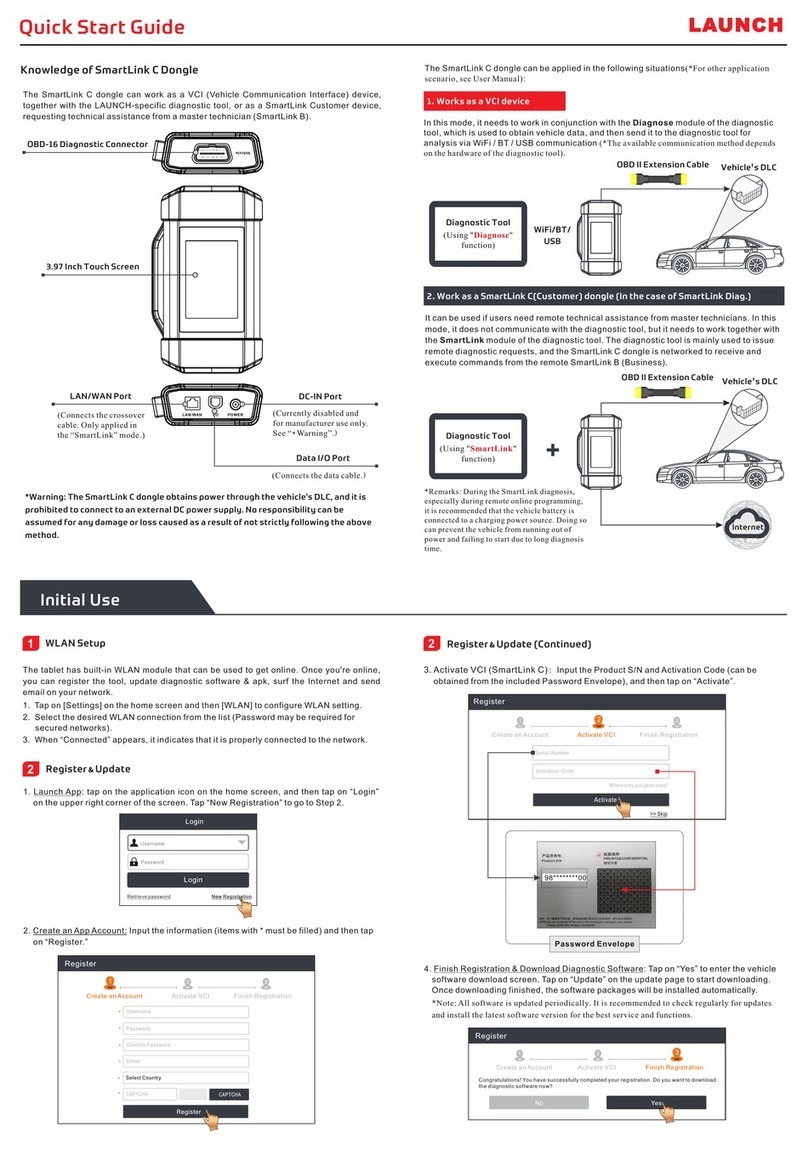
Launch
Launch SmartLink C Dongle quick start guide
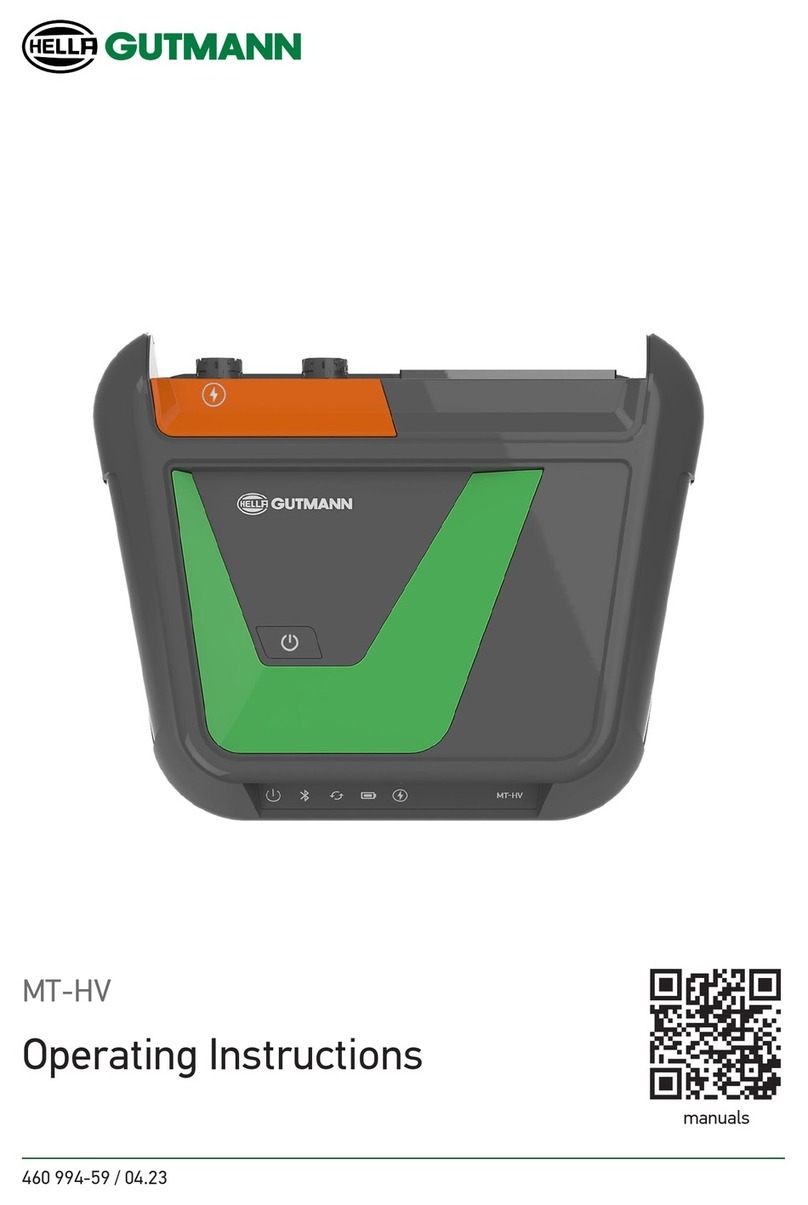
Hella Gutmann
Hella Gutmann MT-HV operating instructions
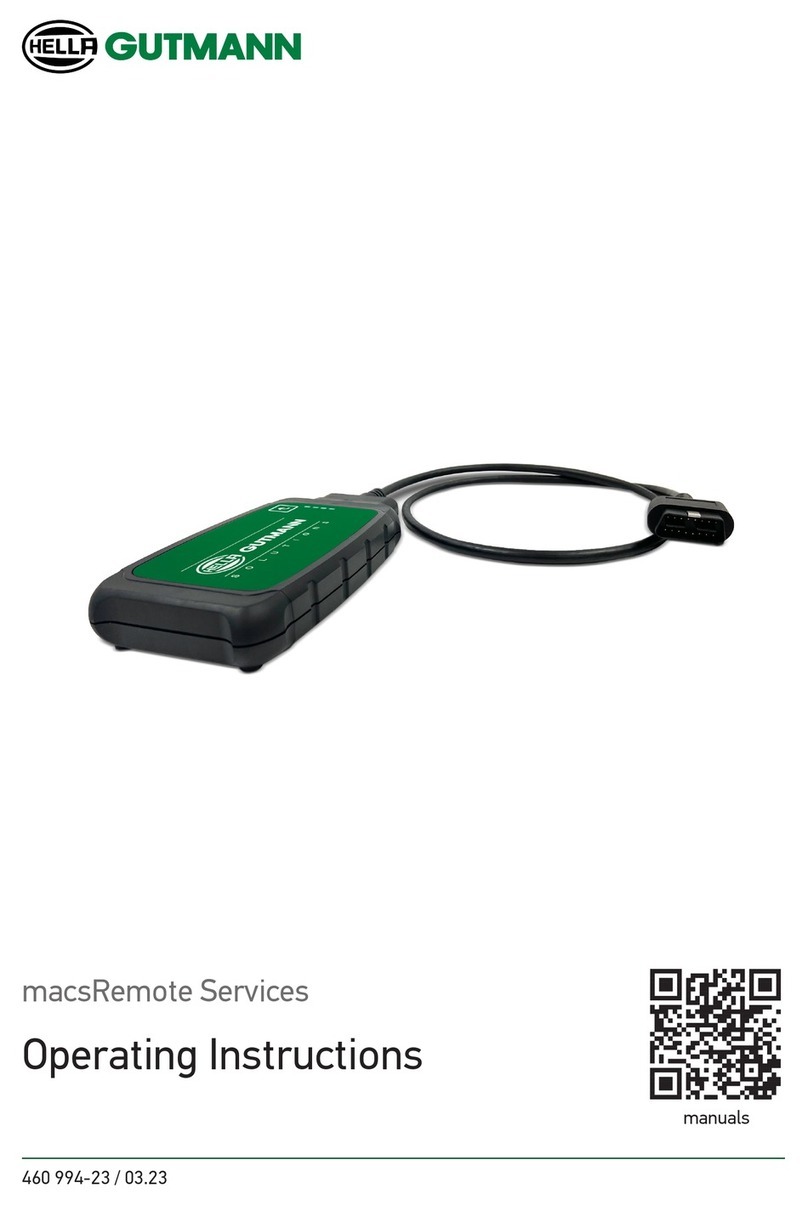
Hella Gutmann
Hella Gutmann macsRemote operating instructions
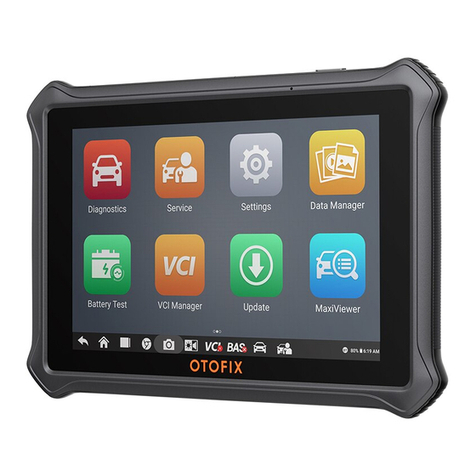
Autel
Autel OTOFIX D1 Pro manual

VOLTCRAFT
VOLTCRAFT BS-200XW operating instructions
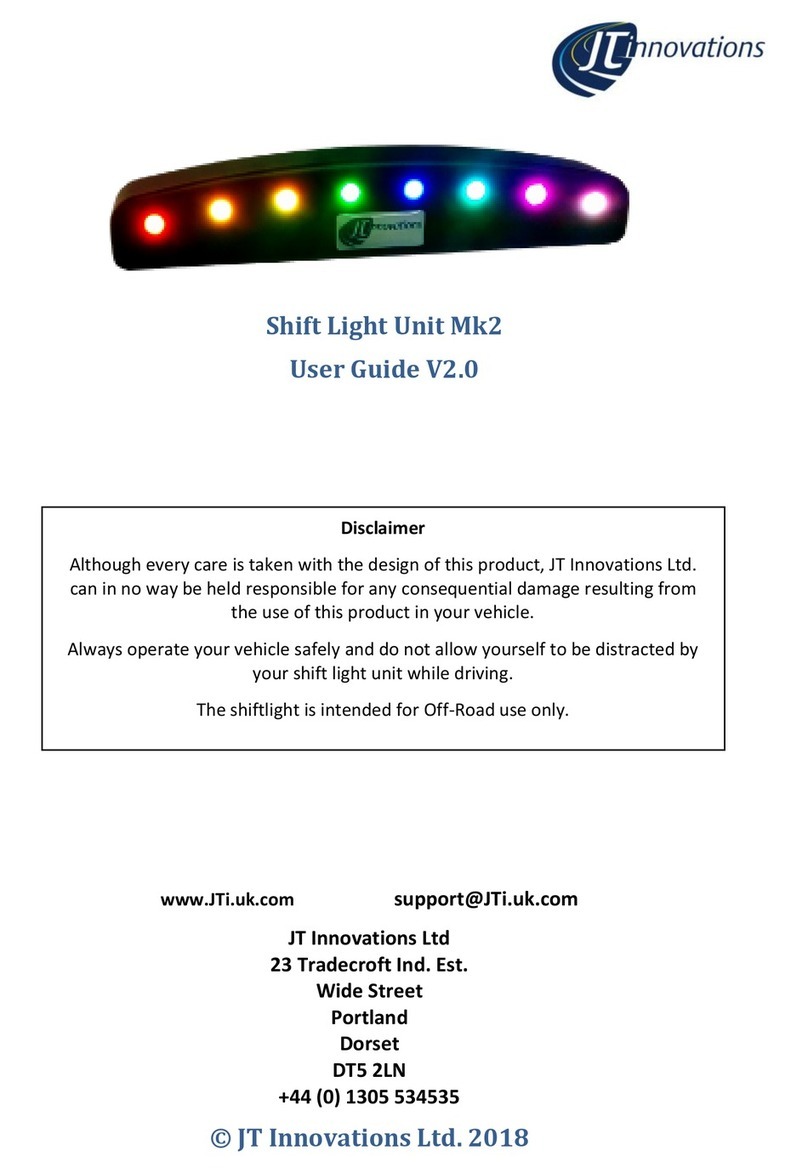
JT Innovations
JT Innovations Shift Light Mk2 user guide
